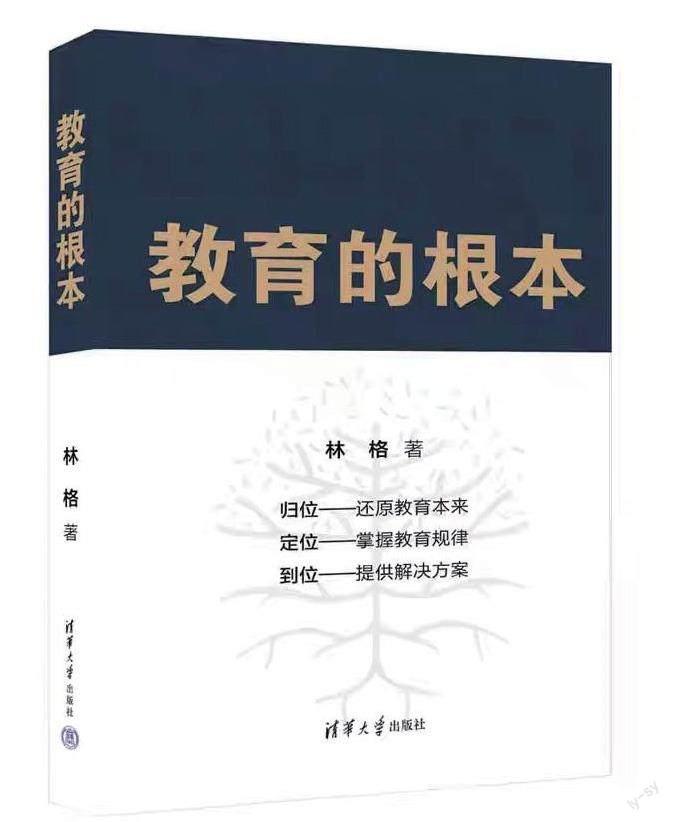Returning to the Root
2023-12-19



This book explores the true essence of education under the background of Chinese modernization from three dimensions: way, law, and technique. It puts forward that we should return to the essence of education and follow the laws of human life development.
Lin Ge
Lin Ge, a famous scholar and an influential Chinese education expert, has been in the grass roots units and visited over a thousand schools in more than a thousand counties in China. He is known as an educator who “engaged in scholarship with his feet.”
The Fundamentals of Education
Lin Ge
Tsinghua University Press
May 2023
88.00 (CNY)
I. Taking root downwards is the direction of growth
Education should return to the root and gain insight into the power of growth at its root. Here we can see the truth of education.
The growth of life is a holistic, comprehensive, and systematic existence. We need to identify the direction we should have as human beings. If a man wants to go up, he must take root downwards. He should forge ahead bravely and do good work. There is no other way.
As for a tree, people pay more attention to its branches, leaves, flowers and fruits. They dont know that such prosperity and harvest lie deeply in its roots forcefully tied downwards. The deeper the roots go, the taller the tree grows. This is another symmetry of life. Nietzsche said: “A man is the same as a tree. The more it pursues the warm and bright sunshine in the high place, the more its roots should stretch towards the dark and humid earth.”
However, taking root is a hard process, take bamboo as an example.
Bamboo is a perennial flowering plant that belongs to the grass family Poaceae. However, it rises from the ground and grows into a tall, straight plant worthy of our awe.
It takes four years for bamboo to grow only three centimeters. From the fifth year, it grows at a rate of 30 centimeters per day. It takes only six weeks for the bamboo to grow to 15 meters. In fact, the bamboo has stretched its roots for several hundred square meters in the soil in the first four years.
The greatest thing about bamboo is taking root. Its roots extend silently under the ground. Every inch of its growth is much more difficult than the leaves swaying in the air. But they are always growing vigorously. We often cannot see or ignore the world of the roots, but it is, in fact, a rich and bold landscape of life expansion.
Roots are the nutritive organ of a plant, which was developed during the long evolution process to adapt to land life. They have rich functions.
First, roots support the whole life of a plant. The reason why a plant can grow firmly on the ground without falling down is the support of its roots. The deeper the roots grow and the wider they stretch, the more powerfully they cling to the soil.
Second, roots are responsible for absorbing water and minerals. The roots can absorb water and minerals such as nitrogen, phosphorus, and potassium from the soil for the plant. A plant needs a large amount of water and all kinds of minerals to live, but the content of these substances is limited in the soil. Therefore, the roots must grow constantly and produce many hairs so that they can stretch deep in the soil and absorb enough water and minerals.
Third, roots undertake the transportation function. The roots, stem and leaves of a plant are connected by many tiny tubes. When the roots absorb nutrients such as water and minerals, they will transport the water and nutrients through the tubes to other parts, including the stem, leaves, flowers, and fruits. Therefore, transportation is an important function of roots.
The world of roots is grand and wonderful. The root tips and hairs stretch and advance all the time. This is the song of life. A plant can stay in peace with roots and will stagger without roots. The tranquility, extension and progress between heaven and earth flow in its life.
Taking root is a metaphor for human growth.
Trees can transform the water and nutrients in the soil into the nutrition for life, because trees have roots. They can transform thunder and lightning into the courage and strength to stand in the world. The same is true of the grasses in the mountains. Because the roots are in the soil and grow soft and strong, the grasses are full of the beauty of life. How to take root? When a plant takes root, it may come across stones, tiles, and saline-alkali soil and may also be attacked by a lot of diseases, pests, bacteria, and fungi. Therefore, the essence of taking root is understanding and acceptance of facing darkness, loneliness, pains, and helplessness. The process of understanding and acceptance is the process of root growth.
What is the root of men? The kindness at the bottom of the heart, the support of virtue, the height of personality, and the responsibility of life. As long as a man takes root, he can constantly absorb nutrition and produce infinite vitality in life, no matter what hardships and difficulties he encounters. When we look at people walking, someone has roots under his feet, and every step he makes is practical and solid; if someone has no roots, people will feel uneasy or depressed at his footsteps. A man with roots will never fall down. He can lower his head and endure occasionally, but he will never yield. Even if he is stricken by poverty for a while, he will still shine in the corner. A man without roots will slide anywhere it goes as if he were stepping on a banana peel. He will be taken away by so-called external opportunities at any time. Once he comes across big difficulties, he will immediately surrender.
Chinas education has come to a new era of taking root.
The root is the cause, which is quiet. Blooming flowers and producing fruits are the result, which is noisy. The roots in the soil are solid and quiet. You can see green leaves and beautiful flowers in the woods. The beauty is actually given by the roots deep in the soil.
Education should be closer to the roots and farther away from the branches and leaves.
Education includes two aspects: noumenon and instrumentality. The development of the roots is noumenon; blooming flowers and producing fruits is instrumentality. The instrumentality and noumenon of education should be combined. Only once we promote peoples all-around development and improve peoples value and quality of life can we better serve society, politics, and the economy.
Every inch downward a man takes root, his expression will get deeper, and what he realizes will be more profound, clear, and firm. Apart from an individual, a nation or a state can stand in the forest of nations in the world only when it is deeply rooted in the soil of its traditional culture. In this way, it will never be moved by temporary waves and trends. External storms and disturbances can only make its roots deeper and stronger. This is both cultural confidence and educational confidence. Taking roots requires a kind of power. First, where should it be rooted? The 5,000 years of Chinese culture are profound and nutritious. Only if ones life is rooted in it can the power be solid. Next, where does the power come from? The power cannot be obtained from the outside. Only the conscience deep in our mind can give us continuous strength. Whatever we come across, we should ask our conscience. It reserves infinite life energy and will give us the answers to all the questions.
